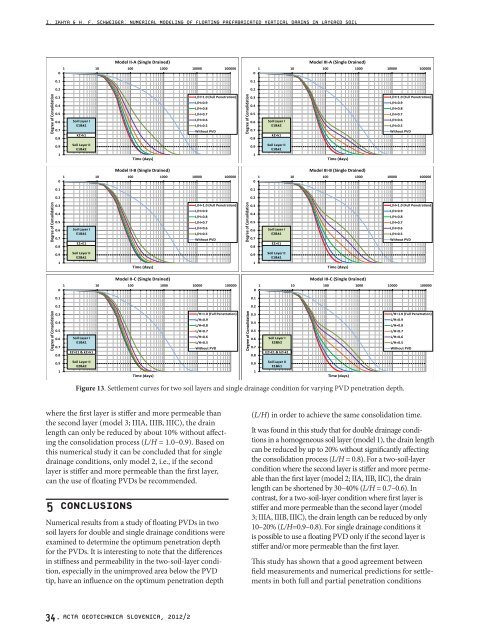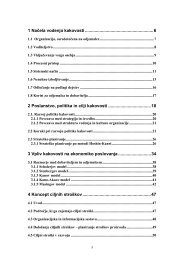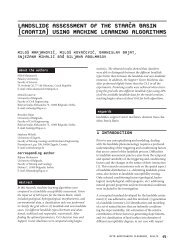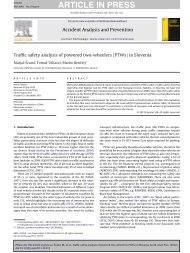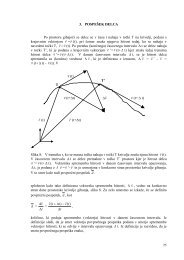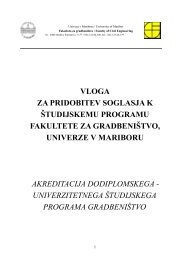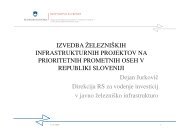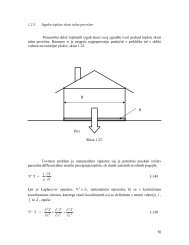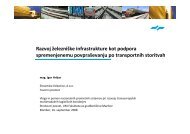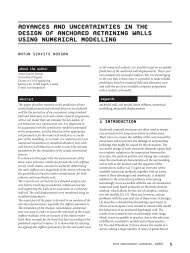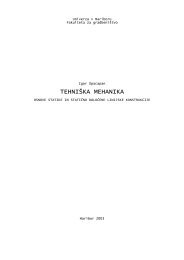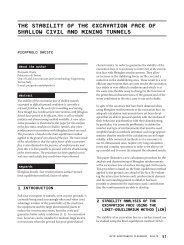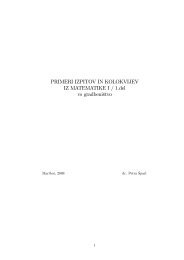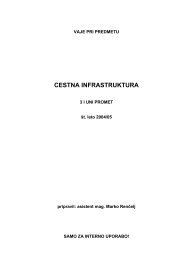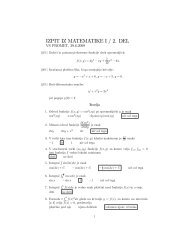Numerical modelin of floating prefabricated vertical drains in layered ...
Numerical modelin of floating prefabricated vertical drains in layered ...
Numerical modelin of floating prefabricated vertical drains in layered ...
You also want an ePaper? Increase the reach of your titles
YUMPU automatically turns print PDFs into web optimized ePapers that Google loves.
I. IKHYA & H. F. SCHWEIGER: NUMERICAL MODELING OF FLOATING PREFABRICATED VERTICAL DRAINS IN LAYERED SOIL<br />
Degree <strong>of</strong> Consolidation<br />
Degree <strong>of</strong> Consolidation<br />
Degree <strong>of</strong> Consolidation<br />
Model II-A (S<strong>in</strong>gle Dra<strong>in</strong>ed)<br />
1 10 100 1000 10000 100000<br />
0<br />
0.1<br />
0.2<br />
0.3<br />
L/H=1.0 (Full Penetration)<br />
L/H=0.9<br />
0.4<br />
L/H=0.8<br />
0.5<br />
L/H=0.7<br />
0.6 Soil Layer I<br />
L/H=0.6<br />
E1&k1<br />
L/H=0.5<br />
0.7<br />
Without PVD<br />
0.8<br />
k2>k1<br />
0.9<br />
1<br />
Soil Layer II<br />
E1&k2<br />
Time (days)<br />
Model II-B (S<strong>in</strong>gle Dra<strong>in</strong>ed)<br />
1 10 100 1000 10000 100000<br />
0<br />
0.1<br />
0.2<br />
0.3<br />
L/H=1.0 (Full Penetration)<br />
L/H=0.9<br />
0.4<br />
L/H=0.8<br />
0.5<br />
L/H=0.7<br />
0.6 Soil Layer I<br />
L/H=0.6<br />
E1&k1<br />
L/H=0.5<br />
0.7<br />
Without PVD<br />
0.8<br />
E2>E1<br />
0.9<br />
1<br />
Soil Layer II<br />
E2&k1<br />
Time (days)<br />
Model II-C (S<strong>in</strong>gle Dra<strong>in</strong>ed)<br />
1 10 100 1000 10000 100000<br />
0<br />
0.1<br />
0.2<br />
0.3<br />
L/H=1.0 (Full Penetration)<br />
L/H=0.9<br />
0.4<br />
L/H=0.8<br />
0.5<br />
L/H=0.7<br />
0.6 Soil Layer I<br />
L/H=0.6<br />
E1&k1<br />
L/H=0.5<br />
0.7<br />
Without PVD<br />
0.8<br />
E2>E1 & k2>k1<br />
0.9<br />
1<br />
Soil Layer II<br />
E2&k2<br />
Time (days)<br />
Figure 13. Settlement curves for two soil layers and s<strong>in</strong>gle dra<strong>in</strong>age condition for vary<strong>in</strong>g PVD penetration depth.<br />
where the first layer is stiffer and more permeable than<br />
the second layer (model 3; IIIA, IIIB, IIIC), the dra<strong>in</strong><br />
length can only be reduced by about 10% without affect<strong>in</strong>g<br />
the consolidation process (L/H = 1.0–0.9). Based on<br />
this numerical study it can be concluded that for s<strong>in</strong>gle<br />
dra<strong>in</strong>age conditions, only model 2, i.e., if the second<br />
layer is stiffer and more permeable than the first layer,<br />
can the use <strong>of</strong> <strong>float<strong>in</strong>g</strong> PVDs be recommended.<br />
5 CONCLUSIONS<br />
<strong>Numerical</strong> results from a study <strong>of</strong> <strong>float<strong>in</strong>g</strong> PVDs <strong>in</strong> two<br />
soil layers for double and s<strong>in</strong>gle dra<strong>in</strong>age conditions were<br />
exam<strong>in</strong>ed to determ<strong>in</strong>e the optimum penetration depth<br />
for the PVDs. It is <strong>in</strong>terest<strong>in</strong>g to note that the differences<br />
<strong>in</strong> stiffness and permeability <strong>in</strong> the two-soil-layer condition,<br />
especially <strong>in</strong> the unimproved area below the PVD<br />
tip, have an <strong>in</strong>fluence on the optimum penetration depth<br />
34. ACTA GEOTECHNICA SLOVENICA, 2012/2<br />
Degree <strong>of</strong> Consolidation<br />
Degree <strong>of</strong> Consolidation<br />
Degree <strong>of</strong> Consolidation<br />
Model III-A (S<strong>in</strong>gle Dra<strong>in</strong>ed)<br />
1 10 100 1000 10000 100000<br />
0<br />
0.1<br />
0.2<br />
0.3<br />
L/H=1.0 (Full Penetration)<br />
L/H=0.9<br />
0.4<br />
L/H=0.8<br />
0.5<br />
L/H=0.7<br />
0.6 Soil Layer I<br />
L/H=0.6<br />
E1&k2<br />
L/H=0.5<br />
0.7<br />
Without PVD<br />
0.8<br />
k2>k1<br />
0.9<br />
1<br />
Soil Layer II<br />
E1&k1<br />
Time (days)<br />
Model III-B (S<strong>in</strong>gle Dra<strong>in</strong>ed)<br />
1 10 100 1000 10000 100000<br />
0<br />
0.1<br />
0.2<br />
0.3<br />
L/H=1.0 (Full Penetration)<br />
L/H=0.9<br />
0.4<br />
L/H=0.8<br />
0.5<br />
L/H=0.7<br />
0.6 Soil Layer I<br />
L/H=0.6<br />
E2&k1<br />
L/H=0.5<br />
0.7<br />
Without PVD<br />
0.8<br />
E2>E1<br />
0.9<br />
1<br />
Soil Layer II<br />
E1&k1<br />
Time (days)<br />
Model III-C (S<strong>in</strong>gle Dra<strong>in</strong>ed)<br />
1 10 100 1000 10000 100000<br />
0<br />
0.1<br />
0.2<br />
0.3<br />
L/H=1.0 (Full Penetration)<br />
L/H=0.9<br />
0.4<br />
L/H=0.8<br />
0.5<br />
L/H=0.7<br />
0.6 Soil Layer I<br />
L/H=0.6<br />
E2&k2<br />
L/H=0.5<br />
0.7<br />
Without PVD<br />
0.8<br />
E2>E1 & k2>k1<br />
0.9<br />
1<br />
Soil Layer II<br />
E1&k1<br />
Time (days)<br />
(L/H) <strong>in</strong> order to achieve the same consolidation time.<br />
It was found <strong>in</strong> this study that for double dra<strong>in</strong>age conditions<br />
<strong>in</strong> a homogeneous soil layer (model 1), the dra<strong>in</strong> length<br />
can be reduced by up to 20% without significantly affect<strong>in</strong>g<br />
the consolidation process (L/H = 0.8). For a two-soil-layer<br />
condition where the second layer is stiffer and more permeable<br />
than the first layer (model 2; IIA, IIB, IIC), the dra<strong>in</strong><br />
length can be shortened by 30–40% (L/H = 0.7–0.6). In<br />
contrast, for a two-soil-layer condition where first layer is<br />
stiffer and more permeable than the second layer (model<br />
3; IIIA, IIIB, IIIC), the dra<strong>in</strong> length can be reduced by only<br />
10–20% (L/H=0.9–0.8). For s<strong>in</strong>gle dra<strong>in</strong>age conditions it<br />
is possible to use a <strong>float<strong>in</strong>g</strong> PVD only if the second layer is<br />
stiffer and/or more permeable than the first layer.<br />
This study has shown that a good agreement between<br />
field measurements and numerical predictions for settlements<br />
<strong>in</strong> both full and partial penetration conditions


